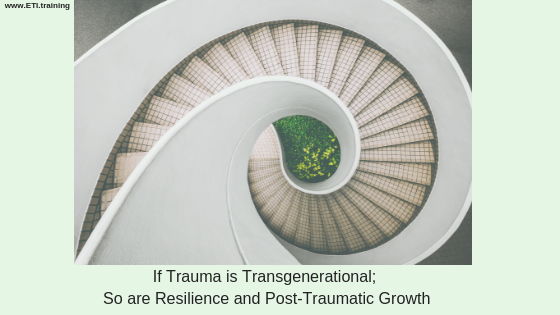Trauma
If Trauma Is Transgenerational, So Are Resilience and PTG
Expand your perspective on resilience and post-traumatic growth.
Posted October 31, 2018

There is a lot being written these days on post-traumatic growth (PTG) and resilience. As a trauma therapist and scholar on trauma responses, I follow these with Google alerts and at least once a week get a batch of new ones.
Typically, they describe resilience as a “process of adapting well in the face of adversity, trauma, tragedy…” and post-traumatic growth as “positive change experienced as a result of the struggle with a major life crisis or a traumatic event."
What wonderful, laudable outcomes. And how utterly disempowering for that vast cohort of trauma survivors who do not feel they are “adapting well” or experiencing “positive changes." Does their misery mean that they are not resilient or not capable of growth after trauma?
I am sorry to say that most professionals, and the literature, frame resilience, and PTG in this way. In my view, it does a great disservice to survivors’ emotional well-being and to the possibility of their experiencing these outcomes.
Expansive definitions can make all the difference
My experiences as a survivor of trauma and therapist have driven me to expand the widely-accepted definitions of these terms and explore ways of using them in practice different from how many professionals use them.
In an earlier post I suggested that, rather than viewing resilience as some desirable trait or capacity individuals may or may not have, we should view it more broadly, as a range of responses enabling us to survive in the face of adversities. This broader understanding enables us to recognize and value resources - often existing in spades in survivors — that we might otherwise ignore or even despise.
For example, anxiety, stress symptoms, numbing, dissociation – or virtually whatever other difficult or painful symptoms of trauma we could name — can all help us survive. Each has the potential to make us more alert to life-threatening danger, prevent us from getting in harm’s way or shelter us from bearing the full brunt of intolerable pain. These are not pleasant or obviously “positive” responses to endure, but their presence can nevertheless make it possible to cope and survive in adverse settings.
We must acknowledge, of course, that however life-preserving these symptoms may be in certain moments, they also place a very high cost upon survivors. Often, they are triggered needlessly and turn out to be false alarms raised by an over-alert (hyper/hypo) nervous system. Their chronic presence is hard to live with and can cause a lot of shame and pain for survivors.
Nevertheless, over the years, I have discovered the importance of claiming more than nicely tamed positive emotions and outcomes as evidence of resilience. I make it a goal as a therapist to help clients to see each of their symptoms as a creative response to adversity, without whose help the client may not have survived.
Most clients are heartened at the mere thought of such a possibility. In a paradoxical way, many find that when they appreciate the value of symptoms they have long feared and despised, when they honor them as creative responses to their own unique situation, then they can reconsider their symptoms as a set of vulnerabilities that also manifest as resilience.
In addition to acknowledging the contribution that their painful symptoms have made to keeping them alive and safe, I aim to help my clients discover something even more important: Despite everything that happened in the past, and despite the pain and chaos of the present, survivors keep trying. Determination, creativity, courage, and perseverance to survive are among the most important and poorly recognized resources of many survivors.
When we add up the courage required to get out of bed despite the painful reminders of the past that each day (and sometimes every moment) might bring; the persistence, determination and perseverance required to once again choose to try to get better despite repeated failures; and the creativity to act in new ways in circumstances that are often deeply discouraging, we see a rich web of unrecognized capacity and personal resources that is invisible to most survivors.
Working with Clients to Foster PTG
Developing our ability to help clients recognize and claim their resourcefulness is for therapists like digging for gems in a place thought to be a mountain of rubble. Any awareness of personal resources we can help clients uncover is valuable in enabling them to advance in the post-trauma journey.
Tedeschi and Calhoun (2004), who coined the term Post Traumatic Growth, suggested five ways in which survivors often display expanded capacities in the aftermath of trauma:
- Improved and new relationships.
- New possibilities, previously unavailable, become available.
- Greater appreciation of life.
- Better sense of personal strength.
- Spiritual development.
Before considering how to encourage the development of PTG, it is important to set aside common misperceptions about it. One is the notion that survivors who experience PTG have gotten to a place where things are pleasant or easy. An extended longitudinal study conducted by Dekel, Mandl, and Solomon (2010), who followed 103 former Israeli prisoners of war over 30 years, challenges this misconception.
On one hand, the authors found that a very high percentage of the trauma survivors in the study experienced post-traumatic growth (PTG). But on the other, the presence of PTG did not eliminate PTSD symptoms such as hyper/hypo alertness from the lives of survivors. In other words, PTSD can and often does coexist with PTG.
Other misconceptions are that PTG is the silver lining after trauma or that PTG is an indicator of resilience or of strength. Post-traumatic growth is a bigger and perhaps more painful process than widely understood. PTG for most survivors is a process of meaning-making through action, contemplation, and reflection.
How to facilitate PTG
We can use the five domain list of Tedeschi and Calhoun as an orientation point. Actions by survivors that deepen any of these domains lay foundations for PTG.
Therapists know that an objective valued in therapy generally and especially in trauma therapy is increased awareness in survivors of their own resilience. Helping survivors “discover“ their resilience retrospectively in their lives, in reflection on difficult times, recent or long ago, with the understanding of resilience described at the beginning of this post, is a necessary and powerful way to facilitate PTG. The idea that personal responses they detested or felt deeply embarrassed about might actually have served a life-preserving role is tremendously meaningful for some clients.
Maybe the epigenetics of trauma facilitate resilience and possibilities of growth?
There has been a lot of valuable work done in recent years with epigenetics, to understand how trauma is passed from one generation to the next. But few studies have been conducted to measure the transgenerational aspects of resilience and post-traumatic growth.
Maybe it’s time to allow epigenetics to help us recognize and honor mechanisms that contribute more than the passing of pain from parents to children. The insights of epigenetics allow us to recognize that the genes conveyed by trauma survivors to their children carry modifications that make their children unusually vigilant against the possibility of recurrence of the trauma of the parents. In other words, heightened anxiety and stress are passed on to future generations so they can better survive and cope with threats that their ancestors endured.
With this understanding, maybe we can explore the impact of resiliency across generations and help more survivors develop post-traumatic growth.
References
Dekel, S., Mandl, C., & Solomon, Z. (2011). Shared and unique predictors of post‐traumatic growth and distress. Journal of clinical psychology, 67(3), 241-252.
Dekel, S., Mandl, C., & Solomon, Z. (2013). Is the Holocaust implicated in posttraumatic growth in second‐generation Holocaust survivors? A prospective study. Journal of traumatic stress, 26(4), 530-533.
Southwick, S. M., Bonanno, G. A., Masten, A. S., Panter-Brick, C., & Yehuda, R. (2014). Resilience definitions, theory, and challenges: interdisciplinary perspectives. European Journal of Psychotraumatology, 5.
Tedeschi, R. G., & Calhoun, L. G. (2004). Posttraumatic growth: A new perspective on psychotraumatology. Psychiatric Times, 21(4), 58.




